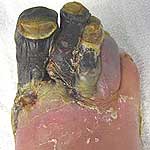On September 22, in a webinar Drs. Bhawisha and Shachindra Joshi of Vile Parle, Mumbai, India, the Dynamic Duo of Homeopathy, will discuss and compare the homeopathic cat remedies (Felidae). They will explore the themes of remedies such as Lac leoninum, Panthera tigris, Lac felinum and Lac puma, among others.
University
Gangrene treatment – new ways to cure gangrene
Gangrene is localized soft-tissue death (necrosis) from prolonged blood-supply blockage. It can occur in atherosclerosis, diabetes mellitus, or decubitus ulcer, and after severe burns or frostbite.
New research studies are finding different new ways to treat gangrene to save body parts.
Gangrene is a dreadful disease in which the profession has failed to offer much in the way of relief for these patients.
Do not overeat in order to please others
If you are a people-pleaser who strives to keep your social relationships smooth and comfortable, you might find yourself overeating in certain social situations like Super Bowl watch parties.
A new study from Case Western Reserve University found that, hungry or not, some people eat in an attempt to keep others comfortable.
Restaurant menu – how do you read?
When you sit down to read a restaurant menu, do you read it like a book? Or do your eyes flit from place to place to find the most enticing dish?
A new study by SF State researcher Sybil Yang, assistant professor of hospitality and tourism management, suggests that on average diners read menus sequentially like a book, and that their gaze doesn’t linger noticeably longer over any particular location on the menu.
CEOs with wider faces have better-performing companies
Believe it or not, one thing that predicts how well a CEO’s company performs is – the width of his face! CEOs with wider faces, like Herb Kelleher, the former … continue reading
When first choice isn’t available, why don’t consumers choose obvious second choice?
Something strange happens when a consumer learns her favorite product choice isn’t available: Instead of picking the runner-up, she’ll reject it for another alternative, according to a new study in the Journal of Consumer Research.
Positive feelings improve consumer decision-making abilities
Consumers who are in a positive mood make quicker and more consistent judgments than unhappy people, according to a new study in the Journal of Consumer Research.
Pregnancy :: Drinking during pregnancy damages brain of unborn
Alcohol consumption during pregnancy is a significant public health problem and may result in a wide range of adverse outcomes for the child. Many Fetal Alcohol Syndrome patients have problems coping with stress; they have learning disabilities, infections, and increased susceptibility to diseases.
Stem Cell :: Human embryonic stem cells derived from preimplantation genetically diagnosed embryos
A human stem cell line derived from embryos that were identified by preimplantation genetic diagnosis (PGD) to carry the mutation for fragile X syndrome has provided an unprecedented view of early events associated with this disease. In addition to giving scientists fresh insight into fragile X, results from this unique model system have emphasized the value of this new source of embryonic stem cells and may have a significant impact on the way that genetic diseases are studied in the future.
Cancer :: Scientific evidence of the significant anti-cancer effect of milk thistle
Recently, scientists demonstrated the anti-cancer effects of silibinin, a major biologically active compound of milk thistle. Being widely used as a folk remedy for liver diseases, milk thistle is safe and well-tolerated, and it protects the liver from drug or alcohol-related injury. Silibinin is highly purified from milk thistle, with a defined chemical structure and molecular weight (C25H22O10, MW: 482.44).

